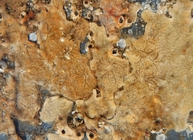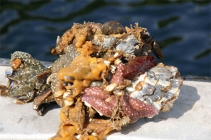
| Intro | | Search taxa | | Browse taxa | | Distributions | | Terminology | | References | | Statistics | | Online sources | | Tutorial | | Log in |
WoRMS taxon detailsDidemnum vexillum Kott, 2002
250126 (urn:lsid:marinespecies.org:taxname:250126)
accepted
Species
Didemnum vestitum Kott, 2004 · unaccepted
Didemnum vestum Kott, 2004 · unaccepted (synonym)
marine,
Kott, P. (2002). A complex didemnid ascidian from Whangamata, New Zealand. <em>Journal of the Marine Biological Association of the UK.</em> 82(4): 625-628., available online at https://doi.org/10.1017/s0025315402005970
page(s): 625 [details] Available for editors
Holotype NMNZ AS259, geounit Whangamata Harbour
Holotype NMNZ AS259, geounit Whangamata Harbour [details]
Shenkar, N.; Gittenberger, A.; Lambert, G.; Rius, M.; Moreira da Rocha, R.; Swalla, B.J.; Turon, X. (2025). Ascidiacea World Database. Didemnum vexillum Kott, 2002. Accessed through: World Register of Marine Species at: https://www.marinespecies.org/aphia.php?p=taxdetails&id=250126 on 2025-04-03
Date action by
Nomenclatureoriginal description
Kott, P. (2002). A complex didemnid ascidian from Whangamata, New Zealand. <em>Journal of the Marine Biological Association of the UK.</em> 82(4): 625-628., available online at https://doi.org/10.1017/s0025315402005970 page(s): 625 [details] Available for editors original description (of Didemnum vestum Kott, 2004) Kott. 2004. Zootaxa 732 : 1-10 [details] original description (of Didemnum vestitum Kott, 2004) Kott, P. (2004). A new species of Didemnum (Ascidiacea, Tunicata) from the Atlantic coast of North America. <em>Zootaxa.</em> 732: 1-10. [details] Available for editors Taxonomytaxonomy source
Lambert, G. (2009). Adventures of a sea squirt sleuth: unraveling the identity of Didemnum vexillum, a global ascidian invader. <em>Aquatic Invasions.</em> 4(1): 5-28., available online at http://www.aquaticinvasions.net/2009/AI_2009_4_1_Lambert.pdf [details] taxonomy source Stefaniak, L.; Lambert, G.; Gittenberger, A.; Zhang, H.; Lin, S.; Whitlatch, R.B. (2009). Genetic conspecificity of the worldwide populations of Didemnum vexillum Kott, 2002. Aquatic Invasions 4(1): 29-44., available online at http://www.aquaticinvasions.net/2009/AI_2009_4_1_Stefaniak_etal.pdf [details] Othercontext source (Introduced species)
Katsanevakis, S.; Bogucarskis, K.; Gatto, F.; Vandekerkhove, J.; Deriu, I.; Cardoso A.S. (2012). Building the European Alien Species Information Network (EASIN): a novel approach for the exploration of distributed alien species data. <em>BioInvasions Records.</em> 1: 235-245., available online at http://easin.jrc.ec.europa.eu [details] Available for editors
additional source Zenetos, A., Gofas, S., Morri, C., Rosso, A, Violanti, D., Garcia Raso, J. E., Cinar, M. E., Almogi-Labin, A., Ates, A. S., Azzurro, E., Ballesteros, E., Bianchi, C. N., Bilecenoglu, M., Gambi, M. C., Giangrande, A., Gravili, C., Hyams-Kaphzan, O., Karachle, P. K., Katsanevakis, S., Lipej, L., Mastrototaro, F., Mineur, F., Pancucci-Papadopoulou, M. A., Ramos Espla, A., Salas, C., San Martin, G., Sfriso, A., Streftaris, N., and Verlaque, M. (2012). Alien species in the Mediterranean Sea by 2012. A contribution to the application of European Union's Marine Strategy Framework Directive (MSFD). Part 2. Introduction trends and pathways. <em>Mediterranean Marine Science.</em> 13(2): 328-352. [details] Available for editors additional source Marchini, A., J. Ferrario, A. Sfriso & A. Occhipinti-Ambrogi. (2015). Current status and trends of biological invasions in the Lagoon of Venice, a hotspot of marine NIS introductions in the Mediterranean Sea. <em>Biological Invasions.</em> 17:2943–2962., available online at https://doi.org/10.1007/s10530-015-0922-3 [details] Available for editors additional source van der Land, J. (ed). (2008). UNESCO-IOC Register of Marine Organisms (URMO). , available online at http://www.marinespecies.org/urmo/ [details] additional source Kott, P.; Bradford-Grieve, J.; Esnal, G.; Murdoch, R.C. (2009). Phylum Tunicata: sea squirts, salps, appendicularians, in: Gordon, D.P. (Ed.) (2009). New Zealand inventory of biodiversity: 1. Kingdom Animalia: Radiata, Lophotrochozoa, Deuterostomia. pp. 409-430. [details] Available for editors  Present Present  Present in aphia/obis/gbif/idigbio Present in aphia/obis/gbif/idigbio  Inaccurate Inaccurate  Introduced: alien Introduced: alien  Containing type locality Containing type locality
Holotype NMNZ AS259, geounit Whangamata Harbour [details]
From editor or global species database
Genetic nomenclature abbreviation Divexi [details]From regional or thematic species database
Introduced species abundance United Kingdom part of the Irish Sea and St. George's Channel (Marine Region): Locally common [details]Introduced species impact United States part of the North Atlantic Ocean (Marine Region) Alters trophic interactions: We show non-native species facilitate native predator population growth by providing a novel temporal resource that prevents loss of predator biomass when its native prey species are rare. [details] Introduced species impact in United Kingdom part of the Celtic Sea (Marine Region) : Loss of aquaculture/commercial/recreational harvest or gain [details] Introduced species impact in United Kingdom part of the English Channel (Marine Region) : Outcompetes native species for resources and/or space [details] Introduced species impact in Canadian part of the Bay of Fundy (Marine Region) : Other impact - undefined or uncertain [details] Introduced species impact New Zealand part of the South Pacific Ocean (Marine Region) : Loss of aquaculture/commercial/recreational harvest or gain [details] Introduced species impact New Zealand part of the South Pacific Ocean (Marine Region) : Water abstraction or nuisance fouling [details] Introduced species impact United Kingdom part of the Irish Sea and St. George's Channel (Marine Region) : Outcompetes native species for resources and/or space [details] Introduced species impact in Dutch part of the North Sea : Loss of aquaculture/commercial/recreational harvest or gain [details] Introduced species impact United States part of the North Atlantic Ocean (Marine Region) Outcompetes native species for resources and/or space: Taken together, these characteristics demonstrate that D. vexillum is an effective competitor, particularly when it comes to occupying open substrate in areas with low propagule pressure (such as new or recently cleaned aquaculture equipment). However, it is not the ultimate competitor with superior resistance to predators, as was suggested by early observational data of newly discovered populations. [details] Introduced species impact United States part of the North Atlantic Ocean (Marine Region) Outcompetes native species for resources and/or space: D. vexillum appears to be the key driver of biodiversity decline in the epibenthos when present, rather than other processes such as direct disturbance and extraction from dredging. This research evaluates ecological responses to the presence of an invasive tunicate and suggests that this invasive species is a major force in shaping the ecological interactions in invaded areas. [details] Introduced species impact United States part of the North Atlantic Ocean (Marine Region) Alters trophic interactions: D. vexillum appears to be the key driver of biodiversity decline in the epibenthos when present, rather than other processes such as direct disturbance and extraction from dredging. This research evaluates ecological responses to the presence of an invasive tunicate and suggests that this invasive species is a major force in shaping the ecological interactions in invaded areas. [details] Introduced species impact in United States part of the North Atlantic Ocean (Marine Region) : Adverse habitat modification [details] Introduced species impact in New Zealand (Nation) : Water abstraction or nuisance fouling [details] Introduced species impact in United States part of the North Atlantic Ocean (Marine Region) : Loss of aquaculture/commercial/recreational harvest or gain [details] Introduced species remark New Zealand part of the South Pacific Ocean (Marine Region) : D. vexillum is considered a serious and persistent fouling pest to their commercial shipping industry and ports (Coutts and Forrest 2007). [details] Introduced species remark New Zealand part of the South Pacific Ocean (Marine Region) : Didemnum vexillum is considered a major threat to New Zealand's mussel industry because of its demonstrated invasiveness on artificial structures, and its ability to over-grow and smother mussels (Coutts and Forrest 2007). [details] Introduced species remark in United States part of the North Atlantic Ocean (Marine Region) : This paper does not represent a new record but establishes the invasiveness of the species at this location. [details] Introduced species vector dispersal New Zealand part of the Tasman Sea (Marine Region) Natural dispersal [details] Introduced species vector dispersal United States part of the North Pacific Ocean (Marine Region) Aquaculture: accidental [details] Introduced species vector dispersal in Dutch part of the North Sea : Shipping [details] Introduced species vector dispersal in United Kingdom part of the Celtic Sea (Marine Region) : Debris: transport of species on human generated debris [details] Introduced species vector dispersal United Kingdom part of the Irish Sea and St. George's Channel (Marine Region) : Recreational equipment: accidental with recreational equipment [details] Introduced species vector dispersal in Dutch part of the North Sea : Fisheries: accidental with deliberate translocations of fish or shellfish [details] Introduced species vector dispersal in Dutch part of the North Sea : Ships: accidental as attached or free-living fouling organisms [details] Introduced species vector dispersal in New Zealand part of the South Pacific Ocean (Marine Region) : Fisheries: accidental with fishery products, packing or substrate [details] Introduced species vector dispersal United States part of the North Atlantic Ocean (Marine Region): Recreational equipment: accidental with recreational equipment [details] Introduced species vector dispersal Spanish part of the Balearic Sea (Marine Region) Fisheries: accidental with deliberate translocations of fish or shellfish [details] Introduced species vector dispersal Spanish part of the Balearic Sea (Marine Region) Ships: general [details] Introduced species vector dispersal New Zealand part of the South Pacific Ocean (Marine Region) : Ships: accidental with ballast water, sea water systems, live wells or other deck basins [details] Introduced species vector dispersal in United States (Nation) : Ships: accidental as attached or free-living fouling organisms [details] Introduced species vector dispersal in New Zealand (Nation) : Fisheries: accidental with deliberate translocations of fish or shellfish [details] Introduced species vector dispersal in United States part of the North Atlantic Ocean (Marine Region) : The specific vector of the D. vexillum introduction is uncertain although international shipping, local boat traffic, and/or shellfish imports are among the most likely sources. [details]
Marine Life Information Network - UK
To Barcode of Life (167 barcodes) To European Nucleotide Archive, ENA (Didemnum vexillum) To GenBank (491 nucleotides; 473 proteins) To Information system on Aquatic Non-Indigenous and Cryptogenic Species (AquaNIS) To PESI To USNM Invertebrate Zoology Chordata Collection (Holotype USNM 1069121) (from synonym Didemnum vestum Kott, 2004) |


